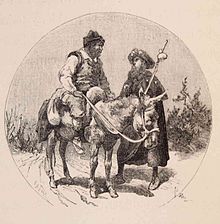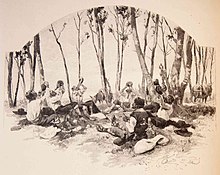
Don Quixote, the full title being The Ingenious Gentleman Don Quixote of La Mancha, is a Spanish novel by Miguel de Cervantes. It was originally published in two parts, in 1605 and 1615. Considered a founding work of Western literature, it is often labelled as the first modern novel. Don Quixote is also one of the most-translated books in the world and one of the best-selling novels of all time.

Miguel de Cervantes Saavedra was an Early Modern Spanish writer widely regarded as the greatest writer in the Spanish language and one of the world's pre-eminent novelists. He is best known for his novel Don Quixote, a work considered as the first modern novel. The novel has been labelled by many well-known authors as the "best book of all time" and the "best and most central work in world literature".
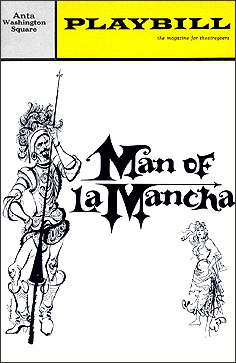
Man of La Mancha is a 1965 musical with a book by Dale Wasserman, music by Mitch Leigh, and lyrics by Joe Darion. It is adapted from Wasserman's non-musical 1959 teleplay I, Don Quixote, which was in turn inspired by Miguel de Cervantes and his 17th-century novel Don Quixote. It tells the story of the "mad" knight Don Quixote as a play within a play, performed by Cervantes and his fellow prisoners as he awaits a hearing with the Spanish Inquisition. The work is not and does not pretend to be a faithful rendition of either Cervantes' life or Don Quixote. Wasserman complained repeatedly about people taking the work as a musical version of Don Quixote.

Moriscos were former Muslims and their descendants whom the Catholic Church and Habsburg Spain commanded to forcibly convert to Christianity or face compulsory exile after Spain outlawed Islam. Spain had a sizeable Muslim population, the mudéjars, in the early 16th century.

La Mancha is a natural and historical region in the Spanish provinces of Albacete, Cuenca, Ciudad Real, and Toledo. It is a fertile plateau that stretches from the mountains of Toledo to the western spurs of the Cuenca hills, bordered to the south by the Sierra Morena and to the north by the Alcarria. The La Mancha historical comarca constitutes the southern portion of Castilla-La Mancha autonomous community and makes up most of the present-day administrative region.

Sancho Panza is a fictional character in the novel Don Quixote written by Spanish author Miguel de Cervantes Saavedra in 1605. Sancho acts as squire to Don Quixote and provides comments throughout the novel, known as sanchismos, that are a combination of broad humour, ironic Spanish proverbs, and earthy wit. "Panza" in Spanish means "belly".

Rocinante (Rozinante) is Don Quixote's horse in the 1605/1615 novel Don Quixote by Miguel de Cervantes. In many ways, Rozinante is not only Don Quixote's horse, but also his double; like Don Quixote, he is awkward, past his prime, and engaged in a task beyond his capacities.

Monsignor Quixote is a novel by Graham Greene, published in 1982. The book is a pastiche of the classic 1605 and 1615 Spanish novel Don Quixote by Miguel de Cervantes with many moments of comedy, but also offers reflection on matters such as life after a dictatorship, Communism, and the Catholic faith.

Alonso Fernández de Avellaneda is the pseudonym of a man who wrote a sequel to Cervantes' Don Quixote, before Cervantes finished and published his own second volume.
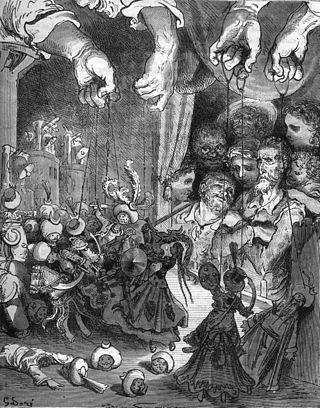
El retablo de maese Pedro is a puppet-opera in one act with a prologue and epilogue, composed by Manuel de Falla to a Spanish libretto based on an episode from Don Quixote by Miguel de Cervantes. The libretto is an abbreviation of chapter 26 of the second part of Don Quixote, with some lines added from other parts of the work. Falla composed this opera "in devoted homage to the glory of Miguel de Cervantes" and dedicated it to the Princess de Polignac, who commissioned the work. Because of its brief length by operatic standards, its very challenging part for a boy opera performer, and its use of puppets, it is not part of the standard operatic repertoire.

Cide Hamete Benengeli is a fictional Arab Muslim historian created by Miguel de Cervantes in his novel Don Quixote, who Cervantes says is the true author of most of the work. This is a skilful metafictional literary pirouette that seems to give more credibility to the text, making the reader believe that Don Quixote was a real person and the story is decades old. However, it is obvious to the reader that such a thing is impossible, and that the pretense of Cide Hamete's work is meant as a joke.

Quixotism is impracticality in pursuit of ideals, especially those ideals manifested by rash, lofty and romantic ideas or extravagantly chivalrous action. It also serves to describe an idealism without regard to practicality. An impulsive person or act might be regarded as quixotic.

Ricote is a Spanish municipality in the autonomous community of Murcia. It has a population of 1,509 (2004) and an area of 87.7 km2.
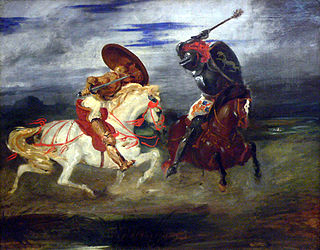
During the Middle Ages, Medieval Europe was engaged in constant warfare. European warfare during the Middle Ages was marked by a transformation in the character of warfare from antiquity, changing military tactics, and the role of cavalry and artillery. In addition to military, tactical and technological innovations during this period, chivalric military and religious ideals arose, giving motivation for engagement in the ceaseless warfare. In the Iberian Peninsula, chivalric ideals and institutions would be adopted and exercised with more fervour than anywhere else.
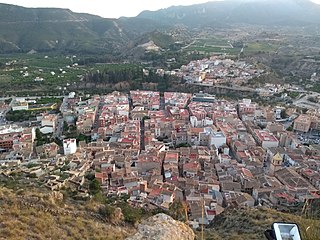
Blanca is a Spanish municipality in the Region of Murcia, located in the "Vega Alta del Segura". It belongs to one of the six municipalities of the Ricote Valley, together with Abarán, Ojós, Ricote, Ulea, Archena and Villanueva de Segura. Blanca limits on the north by the municipality of Abarán, on the south by those of Ulea and Ojós, on the east by the municipalities Molina de Segura and Fortuna, and on the west by the municipality Ricote. Blanca has an area of 87.7 km ², its average height is 233 m and the village has 6489 inhabitants, according to the INE in 2011.
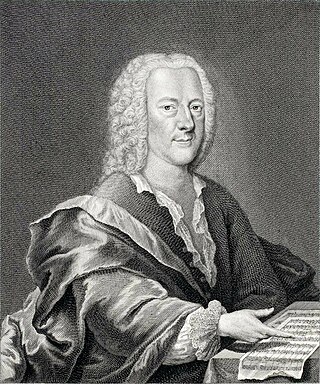
Don Quichotte auf der Hochzeit des Comacho, TVWV 21:32, is a one-act comic serenata by Georg Philipp Telemann. The libretto by the student poet Daniel Schiebeler is based on chapter 20 of volume 2 of Cervantes's novel Don Quixote. The opera premiered on 5 November 1761 in Hamburg. When first performed, it was given the title: Don Quichotte auf der Hochzeit des Comacho; later it was also known as Don Quixote der Löwenritter.

Juan de la Cuesta (?-1627) was a Spanish printer known for printing the first editions of Don Quixote de la Mancha (1605) and the Novelas ejemplares (1613), by Miguel de Cervantes, as well as the works of other leading figures of Spain's Golden Age, such as Lope de Vega.

Don Quixote, Knight Errant is a 2002 Spanish adventure film directed and written by Manuel Gutiérrez Aragón, consisting of an adaptation of the second part of Miguel de Cervantes' Don Quixote. It stars Juan Luis Galiardo and Carlos Iglesias respectively as Don Quixote and Sancho Panza, alongside Santiago Ramos, Fernando Guillén Cuervo, Manuel Manquiña, Kiti Manver, Manuel Alexandre, Juan Diego Botto and Emma Suárez.
